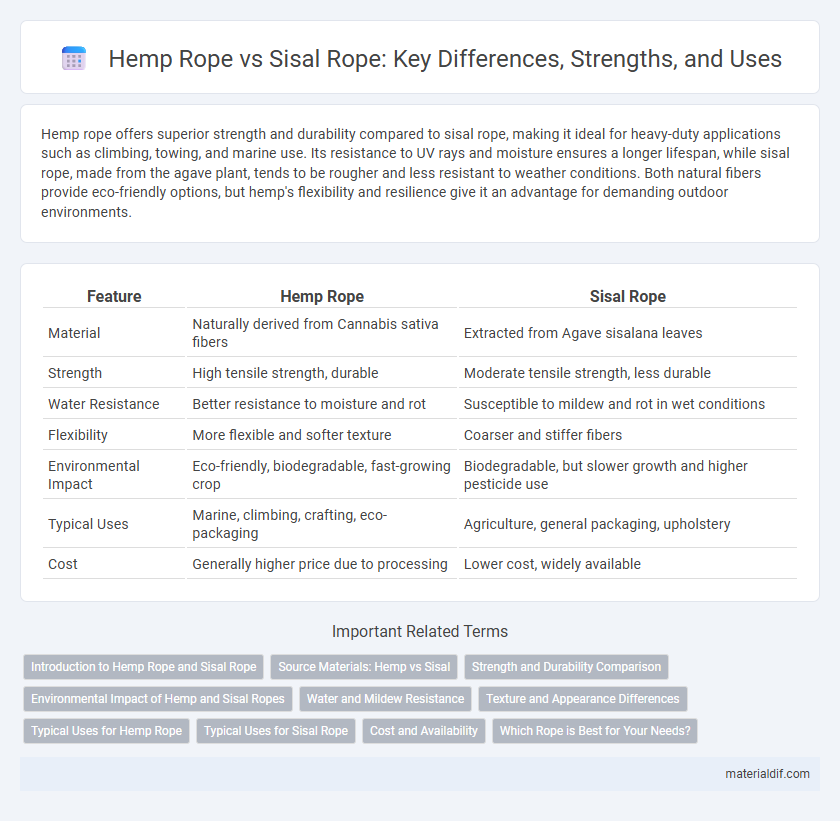Hemp rope offers superior strength and durability compared to sisal rope, making it ideal for heavy-duty applications such as climbing, towing, and marine use. Its resistance to UV rays and moisture ensures a longer lifespan, while sisal rope, made from the agave plant, tends to be rougher and less resistant to weather conditions. Both natural fibers provide eco-friendly options, but hemp's flexibility and resilience give it an advantage for demanding outdoor environments.
Table of Comparison
| Feature | Hemp Rope | Sisal Rope |
|---|---|---|
| Material | Naturally derived from Cannabis sativa fibers | Extracted from Agave sisalana leaves |
| Strength | High tensile strength, durable | Moderate tensile strength, less durable |
| Water Resistance | Better resistance to moisture and rot | Susceptible to mildew and rot in wet conditions |
| Flexibility | More flexible and softer texture | Coarser and stiffer fibers |
| Environmental Impact | Eco-friendly, biodegradable, fast-growing crop | Biodegradable, but slower growth and higher pesticide use |
| Typical Uses | Marine, climbing, crafting, eco-packaging | Agriculture, general packaging, upholstery |
| Cost | Generally higher price due to processing | Lower cost, widely available |
Introduction to Hemp Rope and Sisal Rope
Hemp rope, made from the fibers of the Cannabis sativa plant, is renowned for its durability, resistance to UV light, and natural resistance to mold and mildew, making it ideal for outdoor and marine use. Sisal rope, derived from the Agave sisalana plant, offers strong tensile strength and is biodegradable but is less resistant to moisture and decay compared to hemp. Both ropes are popular for environmental sustainability, but hemp rope provides superior longevity and strength in harsh conditions.
Source Materials: Hemp vs Sisal
Hemp rope is derived from the fibers of the Cannabis sativa plant, known for its durability, flexibility, and resistance to mold and UV light. Sisal rope originates from the leaves of the Agave sisalana plant, valued for its stiffness, coarse texture, and natural resistance to moisture but lower elasticity compared to hemp. The choice between hemp and sisal rope depends on the application requirements, where hemp offers superior strength and longevity, while sisal provides a more rigid, eco-friendly option.
Strength and Durability Comparison
Hemp rope offers superior tensile strength, typically ranging from 1,200 to 3,800 pounds per square inch, making it highly resilient for heavy-duty applications. Sisal rope generally has lower strength, around 700 to 1,700 pounds per square inch, which limits its use to lighter tasks. In terms of durability, hemp rope exhibits greater resistance to rot, mildew, and UV exposure, extending its lifespan in outdoor and marine environments compared to the more brittle and less weather-resistant sisal rope.
Environmental Impact of Hemp and Sisal Ropes
Hemp rope offers a lower environmental impact than sisal rope due to its faster growth cycle and higher carbon sequestration ability, absorbing up to 15 tons of CO2 per hectare annually. Sisal rope, derived from the Agave sisalana plant, requires more water and fertilizer inputs, increasing its ecological footprint. Hemp's biodegradability and minimal pesticide needs make it a more sustainable choice for eco-conscious rope production.
Water and Mildew Resistance
Hemp rope offers superior water resistance compared to sisal rope, making it less prone to absorbing moisture and retaining strength when exposed to wet conditions. Sisal rope, derived from agave fibers, tends to absorb water more readily, increasing susceptibility to mildew and decay over time. The natural oils in hemp fibers provide enhanced mildew resistance, extending the rope's durability in marine and outdoor applications.
Texture and Appearance Differences
Hemp rope boasts a smooth, firm texture with a natural golden-brown color that darkens over time, offering a more uniform and polished appearance compared to sisal rope. Sisal rope features a coarser, more fibrous texture with a lighter cream to off-white hue, often exhibiting a rougher, more rustic look. The tighter fiber weave of hemp provides greater durability and a cleaner finish, making it preferable for applications requiring strength and aesthetic appeal.
Typical Uses for Hemp Rope
Hemp rope is commonly used in marine applications, agriculture, and landscaping due to its strength, durability, and resistance to UV rays and mold. It is ideal for mooring, towing, and rigging because it maintains flexibility even when wet. Hemp rope also serves well in crafting, construction, and as a natural fiber alternative in eco-friendly packaging.
Typical Uses for Sisal Rope
Sisal rope is commonly used for gardening, landscaping, and agricultural applications due to its natural resistance to moisture and durability. It is ideal for tying plants, securing bundles, and creating rustic decorations or craft projects. The coarse texture of sisal rope also makes it suitable for cat scratching posts and marine uses where grip is essential.
Cost and Availability
Hemp rope generally costs more than sisal rope due to its higher durability and eco-friendly production methods, making it a preferred choice for sustainable applications. Sisal rope is more widely available and often cheaper, benefiting from abundant cultivation in tropical regions and mass production. Cost efficiency and availability depend on regional supply chains, with sisal dominating in cost-sensitive markets and hemp favored where quality and longevity justify the investment.
Which Rope is Best for Your Needs?
Hemp rope offers superior strength, durability, and resistance to UV rays compared to sisal rope, making it ideal for outdoor applications and heavy-duty tasks. Sisal rope is more affordable and biodegradable, providing excellent grip and flexibility for gardening, crafts, and light-duty use. Choosing between hemp and sisal depends on your specific needs for strength, environmental exposure, and budget considerations.
Hemp rope vs Sisal rope Infographic

 materialdif.com
materialdif.com